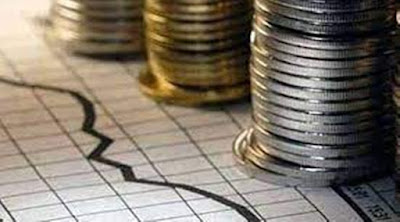The pendulum of market sentiment swings dramatically. It has swung from nearly everyone and their sister complaining that the Federal Reserve was lagging behind the surge in prices to fear of a recession. On June 15, at the conclusion of the last FOMC meeting, the swaps market priced in a 4.60% terminal Fed funds rate. That seemed like a stretch, given the headwinds the economy faces that include fiscal policy and an energy and food price shock on top of monetary policy tightening. It is now seen closer to 3.5%. It is lower now than it was on when the FOMC meeting concluded on May 4 with a 50 bp hike. In addition to the tightening of monetary policy and the roughly halving of the federal budget deficit, the inventory cycle, we argued was mature and would not
Topics:
Marc Chandler considers the following as important: 4.) Marc to Market, 4) FX Trends, Bank of Japan, ECB, Featured, inflation, Interest rates, macro, Monetary Policy, newsletter, Sweden, tax reform, US
This could be interesting, too:
Nachrichten Ticker - www.finanzen.ch writes Die Performance der Kryptowährungen in KW 9: Das hat sich bei Bitcoin, Ether & Co. getan
Nachrichten Ticker - www.finanzen.ch writes Wer verbirgt sich hinter der Ethereum-Technologie?
Martin Hartmann writes Eine Analyse nach den Lehren von Milton Friedman
Marc Chandler writes March 2025 Monthly
The pendulum of market sentiment swings dramatically. It has swung from nearly everyone and their sister complaining that the Federal Reserve was lagging behind the surge in prices to fear of a recession. On June 15, at the conclusion of the last FOMC meeting, the swaps market priced in a 4.60% terminal Fed funds rate. That seemed like a stretch, given the headwinds the economy faces that include fiscal policy and an energy and food price shock on top of monetary policy tightening. It is now seen closer to 3.5%. It is lower now than it was on when the FOMC meeting concluded on May 4 with a 50 bp hike.
In addition to the tightening of monetary policy and the roughly halving of the federal budget deficit, the inventory cycle, we argued was mature and would not be the tailwind it was in Q4. While we recognized that the labor market was strong, with around 2.3 mln jobs created in the first five month, we noted the four-week moving average of weekly jobless claims have been rising for more than two months. In the week to June 17, the four-week moving average stood at 223k. It is a 30% increase from the lows seen in April. It is approaching the four-week average at the end of 2019 (238k), which itself was a two-year high. In addition, we saw late-cycle behavior with households borrowing from the past (drawing down savings and monetizing their house appreciation) and from the future (record credit card use in March and April).
The Fed funds futures strip now sees the Fed's rate cycle ending in late Q1 23 or early Q2 23. A cut is being priced into the last few months of next year. This has knock-on effects on the dollar. We suspect it is an important part of the process that forms a dollar peak. There is still more wood to chop, as they say, and a constructive news stream from Europe and Japan is still lacking. The sharp decline in Russian gas exports to Europe is purposely precipitating a crisis that Germany's Green Economic Minister, who reluctantly agreed to boost the use of coal (though not yet extend the life of Germany's remaining nuclear plants that are to go offline at the end of the year), warns could spark a Lehman-like event in the gas sector.
At the low point last week, the US 10-year yield had declined by around 50 bp from the peak the day before the Fed delivered its 75 bp hike. This eases a key pressure on the yen, and, at the same time, gives the BOJ some breathing space for the 0.25% cap on its 10-year bond. A former Ministry of Finance official cited the possibility of unilateral intervention. While we recognize this as another step up the intervention escalation ladder, it may not be credible. First, it was a former official. It would be considerably more important if it were a current official. Second, by raising the possibility, it allowed some short-covering of the yen, which reduces the lopsided positioning and reduces the impact of intervention. Third, on the margin, it undermines the surprise-value.
Ultimately, the decline in the yen reflects fundamental considerations. The widening of the divergence of monetary policy is not just that other G10 countries are tightening, but also that Japan is easing policy. A couple of weeks ago, to defend its yield-curve-control, the BOJ bought around $80 bln in government bonds. The odds of a successful intervention, besides the headline impact, is thought to be enhanced if it signals a change in policy and/or if it is coordinated (multilateral).
There are a few high frequency data points that will grab attention in the coming days, but they are unlikely to shape the contours of the investment and business climate. The key drivers are the pace that financial conditions are tightening, the extent that China's zero-Covid policy is disrupting its economy and global supply chains, and the uncertainty around where inflation will peak.
Most of the high frequency data, like China's PMI and Japan's industrial production report and the quarterly Tankan survey results, and May US data are about fine-tuning the understanding of Q2 economic activity and the momentum at going into Q3. They pose headline risk, perhaps, but may be of little consequence. It is all about the inflation and inflation expectations: except in Japan. Tokyo's May CPI, released a few weeks before the national figures, is most unlikely to persuade the Bank of Japan that the rise in inflation will not be temporary.
With fear of recession giving inflation a run for its money in terms of market angst, the dollar may be vulnerable to disappointing real sector data, though the disappointing preliminary PMI likely stole some thunder. The Atlanta Fed's GDPNow says the US economy has stagnated in Q2, but this is not representative of expectations. It does not mean it is wrong, but it is notable that the median in Bloomberg's survey is that the US economy is expanding by 3% at an annualized rate. This seems as optimistic as the Atlanta Fed model is pessimistic. May consumption and income figures will help fine-tune GDP forecasts, but the deflator may lose some appeal. Even though the Fed targets the headline PCE deflator, Powell cited the CPI as the switch from 50 to 75 bp hike.
In that light, the preliminary estimate of the eurozone's June CPI that comes at the end of next week might be the most important economic data point. It comes ahead of the July 21 ECB meeting for which the first rate hike in 11 years has been all but promised. Although ECB President Lagarde had seemed to make clear a 25 bp initial move was appropriate, the market thinks the hawks may continue to press and have about a 1-in-3 chance of a 50 bp move. The risk of inflation is still on the upside and Lagarde has mentioned the higher wage settlements in Q2. That said, the investors are becoming more concerned about a recession and expectations for the year-end policy rate have fallen by 30 bp (to about 0.90%) since mid-June.
A couple of days before the CPI release the ECB hosts a conference on central banking in Sintra (June 27-June 29). The topic of this year's event is "Challenges for monetary policy in a rapidly changing world," which seems apropos for almost any year. The conventional narrative places much of the responsibility of the high inflation on central banks. It is not so much the dramatic reaction to the Pandemic as being too slow to pullback. In the US, some argue that the fiscal stimulus aggravated price pressures. On the face of it, the difference in fiscal policy between the US and the eurozone, for example, may not explain the difference between the US May CPI of 8.6% year-over-year and EMU's 8.1% increase, or Canada's 7.7% rise, or the UK's 9.1% pace.
There is a case to be made that we are still too close to the pandemic to put the experience in a broader context. This may also be true because the effects are still rippling through the economies. In the big picture, central banks, leaving aside the BOJ, appear to have responded quicker this time than after the Great Financial Crisis in pulling back on the throttle, even if they could have acted sooner. Some of the price pressures may be a result of some of the changes wrought by the virus. For example, a recent research paper found that over half of the nearly 24% rise in US house prices since the end of 2019 can be explained by the shift to working remotely, for example.
The rise in gasoline prices in the US reflect not only the rise in oil prices, but also the loss of refining capacity. The pandemic disruptions saw around 500k barrels a day of refining capacity shutdown. Another roughly 500k of day of refining capacity shifted to biofuels. ESG considerations, and pressure on shale producers to boost returns to shareholders after years of disappointment have also discouraged investment into the sector. The surge in commodity prices from energy and metals to semiconductors to lumber are difficult to link to monetary or fiscal policies.
Such an explanation would also suggest that contrary to some suggestions, the US is not exporting inflation. Instead, most countries are wrestling with similar supply-driven challenges and disruptions. That said, consider that US core CPI has risen 6% in the year through May, while the ECB's core rate is up 3.8%, and rising. The US core rate has fallen for two months after peaking at 6.5%. The UK's core CPI was up 5.9% in May, its first slowing (from 6.2%) since last September. Japan's CPI stood at 2.5% in May, but the measure excluding fresh food and energy has risen a benign 0.8% over the past 12 months.
Consider Sweden. The Riksbank meets on June 30. May CPI accelerated to 7.3% year-over-year. The underlying rate, which uses a fixed interested rate, and is the rate the central bank has targeted for five years is at 7.2%. The underlying rate excluding energy is still up 5.4% year-over-year, more than doubling since January. The policy rate sits at 0.25%, having been hiked from zero in April. The economy is strong. The May composite PMI was a robust 64.4. The economy appears to be growing around a 3% year-over-year clip. Unemployment, however, remains elevated at 8.5%, up from 6.4% at the end of last year. The swaps market has a 50 bp hike fully discounted and about a 1-in-3 chance of a 75 bp hike. The next Riksbank meeting is not until September 20, and the market is getting close to pricing in a 100 bp hike. Year-to-date, the krona has depreciated 11% against the dollar and about 3% against the euro.
In addition to macroeconomic developments, geopolitics gets the limelight in the coming days. The G7 summit is June 26-28. Coordinating sanctions on Russia will likely dominate the agenda and as the low-hanging fruit has been picked, it will be increasingly challenging to extend them to new areas.
At least two important issues will go unspoken and they arise from domestic US political considerations. Although President Biden has recommended a three-month gas tax holiday, he needs Congress to do it. That is unlikely. Inflation, and in particular gasoline prices are a critical drag on the administration and the Democrats more broadly, who look set to lose both houses. And the Senate and Congressional Republicans are not inclined to soften the blow. Talk of renewing an export ban on gasoline and/oil appears to be picking up. The American president has more discretion here. This type of protectionism needs to be resisted because could it be a slippery slope.
The other issue is the global corporate tax reform. Although many countries, most recently Poland, have been won over, it looks increasingly likely that the US Senate will not approve it. Biden and Yellen championed it, but the votes are not there now, and it seems even less likely they will be there in the next two years. The particulars are new, but the pattern is not. The US has not ratified the Law of the Seas nor is it a member of the International Court of Justice. Some push back and say that the US acts as if it were. That argument will be less persuasive on the corporate tax reform.
NATO meets on June 29-30. For the first time, Japan, Australia, New Zealand, and South Korea will be attending. Clearly, the signal is that Russia's invasion of Ukraine is not distracting from China. Most recently, China pressed its case that the Taiwan Strait is not international waters. Some in Europe, including France, do not want to dilute NATO's mission by extending its core interest to the Asia Pacific area and distracting from European challenges. NATO is to publish a new long-term strategy paper. Consider that the last one was in 2010 and did not mention Beijing and said it would seek a strategic partnership with Russia. Putin's actions broke the logjam in Sweden and Finland, and both now want to join NATO, but Turkey is holding it up.
Tags: Bank of Japan,ECB,Featured,inflation,Interest rates,macro,Monetary Policy,newsletter,Sweden,tax reform,US









